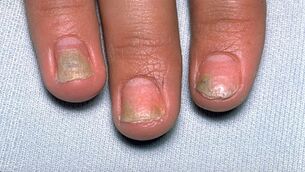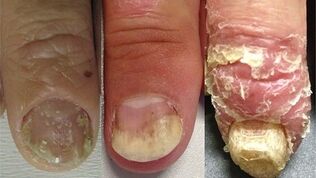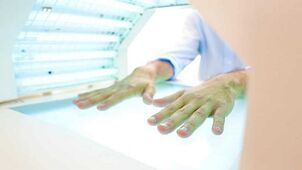One type of dermatological disease, which occurs in chronic form, is nail psoriasis. It can bother adults or children if there are appropriate factors for its spread. The disease has many similarities to normal psoriasis, as it is also characterized by a layer of pathological cells on top of each other, as a result of which there is a strong deformation on the nail plate.
Causes of disease

Some people think that psoriasis on the toenails or nails occurs when there is severe stress. Although it has been scientifically proven that strong emotional experiences cannot lead to such changes. Therefore, they should not be considered the main cause of the development of this disease. Doctors identify 2 factors that can actually cause pathological processes:
- Immune system disorders,are responsible for the formation of healthy cells and the fermentation of nutrients. Such changes do not allow skin particles to fully develop. They begin to grow and overlap. The result is thickening of the nail plate;
- Predisposition to the development of psoriasis.In most patients, the tendency to develop pathology does exist in genes. It wakes up as soon as the body is negatively affected by certain factors.
Several factors can cause the activation of this disease:
- Hormonal failure;
- Metabolic problems;
- Long-term use of anti-inflammatory drugs and beta-blockers;
- Climatic conditions (cold and dry weather);
- Chronic fatigue;
- Infectious wounds;
- Damage to the upper layers of the skin.
In half of the cases, nail psoriasis on the hands or feet develops along with skin lesions.
Psoriasis can only affect the nails or other parts of the body.
The first signs of psoriasis on the nails and toes
Nail lesions on psoriasis can be identified by the characteristic symptoms of this condition. They begin to bother a person from the first days of development of the disease. Common signs of pathological processes include:
- Dents and indentations on the surface of the nail plate;
- Change nail color to darker;
- Inflammatory processes along the nails;
- Itching on the skin of the fingers.
If treatment is not started in the early stages of the disease, it will continue to develop and its clinical manifestations will become clearer.
Level of disease

What does nail psoriasis look like, you can find out if you carefully study the photos showing the affected plates and fingers. In the early stages of development, the pathological manifestations are not very noticeable. The increase in symptoms is observed with the successful spread of psoriasis, in which healthy tissue is affected.
Doctors distinguish 3 main stages of the journey of nail psoriasis:
- Progressive.At this stage, the nails begin to cover with small dots, which are painted white or yellowish brown. Over time, the papules grow larger. At this stage, psoriasis does not affect the deep layers of the nail, so it can be cured quickly. There is no pain when pressing on the affected area, but the surface is slowly peeling off;
- Not moving. Stop points appear on the nail. Along with this, the inflammatory process slows down. However, discomfort or pain persists. Sometimes at this stage, the skin next to the plate is covered with a rash that is a hallmark of the disease. He himself became very dry;
- Regressive.The previously formed rash is actively gone. The whiteness edge appears near the lesion. As a rule, at this stage of the development of psoriasis, patients experience unbearable itching.
Seeing the progression of the disease, the doctor must understand at what stage. This will help them find the best therapy for their patients.
If left untreated, psoriasis will invade new areas.
Diagnostic methods
Experienced specialists who diagnose and treat dermatological diseases can immediately determine if a person has nail psoriasis. Laboratory studies make it possible to confirm the truth of the conclusions drawn. To make a diagnosis, you may need:
- Complete blood count;
- Biopsy or psoriatic scale analysis.
Instrumental diagnostics for nail psoriasis are not required.
How to treat nail psoriasis

Nail psoriasis in children and adults requires complex therapy. One tool or procedure for such a diagnosis is not enough. Treatment for nail psoriasis located on the hands or feet is standard for all patients. Individually, they are selected as drugs and physiotherapy. In addition, patients will be advised to review their daily diet and make significant adjustments to their normal lifestyle. However, the success of the therapy course also depends on this.
As soon as a person sees the signs of nail psoriasis, they should immediately see a dermatologist. What types of symptoms will help identify the disease that has been discussed above.
Most doctors prescribe topical ointments and systemic tablets
Drug therapy
For conditions such as nail psoriasis, treatment can be done at home. The doctor will prescribe a number of medications that must be taken orally or applied to the affected area.
In the early stages of dermatological pathology, topical agents should be used. Ointments and creams can be hormonal or non-hormonal. The first is in dire need of further forms of the disease.
Non-hormonal drugs rarely cause side effects and complications. In addition, they do not cause addiction, in contrast to the more aggressive preparations for external treatment on the nail plate.
If the patient has severe nails, the doctor will recommend oral medication. He will also tell you how to treat nail psoriasis this way and what dosage to follow.
The following medications may be needed for nail psoriasis:
- Immunomodulator (vitamin);
- Antihistamines;
- Calm down.
In most cases, medication is not stopped until the disease has subsided.
Physiotherapy

Finger nail psoriasis is often treated with physiotherapy. Good results for such violations are provided by:
- PUVA therapy;
- X-ray therapy;
- UV irradiation;
- Ultrasound therapy;
- Laser therapy.
In order for the results to be positive only after the procedure, it is necessary to choose the number and duration of physiotherapy sessions correctly. This task should be entrusted to an experienced professional. Otherwise, patients who try to understand how to cure psoriasis will face serious side effects from the procedure.
PUVA therapy is one of the most modern and effective methods.
Proper Nail Care
For treatment to be as effective as possible, a patient with psoriatic disease should pay attention to proper nail care. The disease severely injures their plates, so such treatment will not be excessive. First of all, this is to adhere to the rules of hygiene. Doctors recommend doing the following for this diagnosis:
- Nails should be cut as short as possible;
- When doing household chores, it is recommended to wear protective gloves;
- Avoid work that could injure the nails and surrounding skin;
- Periodically you need to monitor the cleanliness of the nail plate.
Medical methods will be more effective if, in addition to traditional and traditional methods of therapy, patients adhere to these rules.
In psoriasis, it is very important to protect your hands from aggressive exposure.
People's solution
Traditional healers know which plants cure psoriasis that affects the nail plate. They recommend it, like many other ingredients, when preparing home remedies for the treatment of dermatological diseases.
Patients can use the following folk remedies:
- Celandine Broth.To prepare it, you need to pour 0. 5 liters of water 2 tbsp. l. herbs. This mixture must be boiled over low heat. On average, it must be cooked for about 30 minutes. Afterwards, a medicinal bath is made of broth, in which the arms and legs are lowered for 20-25 minutes;
- Natural oils.These foods work well with psoriasis. Sea buckthorn oil is very beneficial. It moisturizes the skin around the nails and enriches them with beneficial trace elements. To treat the affected area with oil, you just need to attach it to a cotton liner, and then run it on a plate. It is recommended to repeat the procedure up to 3 times a day;
- Compress garlic.It is made from medium onions, previously channeled through a meat grinder. The resulting gruel is placed on the nails and covered with a clean gauze bandage. The compress should be left on for 30 minutes;
- Boil the bay leaf.It can also be used during the preparation of medical baths. To make the broth, you need to pour 2 cups of hot water with 20 g of grass. Cook the mixture for no more than 10 minutes. Then the product is cooled to a comfortable temperature and hands or feet are lowered into it. It is also permissible to take such a decoction, 40 g three times a day;
- Boil herbs.For bathing, you can prepare medicines from celandine, chamomile, oak bark, sage and string. They make it the same way as in the previous recipe;
- Herbal infusion.This is intended for oral administration. Homemade medicine is made based on lingonberry leaves, St. John's wort. John, calamus root, celandine and rope. The ingredients are taken in equal proportions. The infusion is made from 1 tbsp. l. collection and a glass of boiling water. It is recommended to take 50 g of the drug 2 times a day.
Folk remedies should be used in conjunction with traditional treatments. Otherwise, they will have no effect.
Therapy Diet

When a person's upper skin layer is affected, a bad diet can be blamed. As a result, the body lacks useful trace elements that support the immune system and other systems. And as you know, due to failure, psoriatic disease occurs. Psoriasis-affected nails can be treated with a special diet. It must be hypoallergenic.
The diet of patients with nail psoriasis should be balanced. It is highly recommended to exclude foods that can cause allergies from it. These are chocolate, strawberries, citrus fruits and coffee. You should also avoid salty, smoked, pickled, spicy and fatty foods. Chopped sweet potatoes, mayonnaise and mustard are prohibited.
During the period of increased autoimmune disease, it is recommended to follow a mono diet, which is planned for 1-2 days. Such a diet involves the use of only 1 product. It can be apples, kefir, fish or cereals.
A therapeutic diet should be enriched with fermented dairy products, fruits, vegetables, herbs and lean fish.
Foods that can cause allergies can also make psoriasis worse.
Prevention
It is easier to try to prevent the development of nail psoriasis than to fight it later. Disease prevention includes several recommendations:
- You need to include plant foods in your diet;
- You should give up fried, smoked, pickled and salty foods;
- It is best to always rest in places with a good climate for the skin and body as a whole;
- Take a vitamin and mineral course in the course;
- Avoid damage to skin and nail plates;
- Treat infectious diseases in a timely manner.
Don't forget to take care of your own skin and nails. This is the only way to protect yourself from the development of psoriasis and its recurrence.
Forecast
Psoriasis is one of the diseases that continues all the time. Medication and physical therapy only temporarily stop the progression of the disease. No one can fully recover. If the patient adheres to the recommendations of the specialist, then he will be able to prevent recurrent damage to the skin and nails.
Complications and Consequences
Psoriatic nail lesions should be treated from the first days of development. If therapy is not available or chosen incorrectly, then patients are at risk of complications and consequences of autoimmune disease.
With nail psoriasis, the cardiovascular system can be severely affected. It is this vessel that threatens the greatest danger, as pathological changes occur in it under the influence of disease.
All forms of psoriasis can cause psychological problems. They are directly related to the fact that others rarely interact normally with people with similar disabilities on different parts of the body. Because of that, the patient withdrew, began to abuse alcohol, he continued to be chased by depressed conditions. Against the background of disturbed psyche, the likelihood of the onset of malignant processes in skin cells increases.























